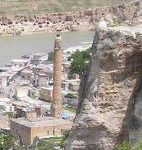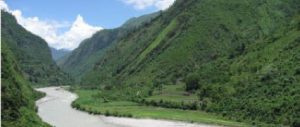Since a group of European backers withdrew funding in July, the fate of the controversial Ilisu dam – and that of the surrounding, mostly Kurdish communities in southeastern Turkey – has been in limbo. The dam, located on the Tigris River, 65 kilometres from the Syrian and Iraqi borders, would power a 1,200-megawatt hydroelectric plant, while displacing tens of thousands of local residents and submerging the ancient city of Hasankeyf beneath a vast reservoir. The project has drawn widespread criticism from environmental groups in Turkey and abroad, who are concerned that it will threaten endangered species, reduce downstream water flows and cause irreparable ecological damage to the Tigris River basin.
The Turkish prime minister Recep Tayyip Erdoğan conducted a ceremonial groundbreaking for the dam in August 2006, and the project was supposed to be completed by 2013. But German, Swiss and Austrian funders called a halt to the construction process in December 2008, amid concerns that the project was failing to meet World Bank standards for environmental and cultural preservation. After a 180-day review period, they withdrew their pledged US$610 million in export credit. It was the second time Ilisu had lost international backing: a previous, British-led consortium abandoned funding for the project in 2001 amid local and international protest. But despite the withdrawal, and with opposition to the dam rising in Turkey itself, the Turkish government has reiterated its determination to build the dam. “Let me tell you this,” environment minister Veysel Eroğlu told reporters after the decision. “These power plants will be built. No one can stop it. This is the decision of the state and the government.”
Ilisu is the most controversial and high-profile of a series of dams planned as part of the US$32 billion Southeastern Anatolian Project (Güneydoğu Anadolu Projesi, or GAP) – a vast regional hydroelectricity, irrigation and development project involving nine provinces in the Euphrates and Tigris basins. The project, launched in the late 1970s, envisions the construction of 22 dams (nine of which have already been completed) and 19 hydroelectric plants. It is intended to increase Turkish energy independence and provide irrigation and power to foster economic development in the impoverished southeast. GAP, administered by the State Hydraulic Works (Devlet Su İşleri, or DSİ), has expanded over the decades into a multi-sector development project that now involves programmes ranging from women’s micro-credit to education for street children. The vast majority of GAP investment, however, is directed to the major infrastructural projects, like Ilisu, that will irrevocably reshape the landscape of southeastern Anatolia.
The troubled history of the Ilisu dam is entwined with that of the Kurdish question in Turkey. The social transformation of GAP was partly framed as a response to the devastating civil war between the Turkish army and the militant Kurdish group known as the PKK (Partiya Karkerên Kurdistan, or Kurdistan Workers’ Party) in the 1980s and 1990s. Today, the Turkish government still views the project as a means for resolving the economic consequences and political scars of the conflict—and for “modernising” a region and population stigmatised as backwards. Although the human rights and political situation in the region has improved, many residents remain deeply wary of the state’s intentions.
Local opposition to Ilisu stems in part from a fear that the Turkish state wants to use infrastructure projects in order to appropriate land, alter local geography, and thereby strengthen its security control over the region. A 2005 fact-finding report by Irish archaeologist Maggie Ronayne for the Kurdish Human Rights Project documented the human rights violations and negative humanitarian consequences that attended other major dam projects in the southeast, and raised concerns that Ilisu’s construction would reproduce many of the same problems. This month, the governing Justice and Development Party (AKP) will unveil a new “Kurdish initiative” intended to resolve the conflict once and for all—but the state continues to view GAP as part of the solution.
Kurdish communities are still coping with the aftermath of the displacement of hundreds of thousands of people who fled or were expelled from their villages during the conflict. The construction of the Birecik and Atatürk dams on the Euphrates displaced thousands more. Because residents of the threatened areas often lack legal land rights, they may be unable to secure compensation for lost homes, land and fishing resources. Göç-Der, an NGO that works on migration and refugee issues and strongly opposes the Ilisu dam, argues that government resettlement plans for people displaced by GAP projects have been grossly inadequate. Göç-Der claims that they raised these concerns in a stakeholder interview with the Ilisu Consortium, only to find that the consortium’s Resettlement Action Plan misrepresented the results of the meeting so grossly as to give the impression that Göç-Der supported the project. Kurdish human rights activists also fear that the reservoir could submerge suspected mass graves of people disappeared by paramilitary forces during the conflict, and the recent exhumation of several “death wells” elsewhere in the southeast have reinforced these concerns.
The international campaign to stop Ilisu has largely focused on the fate of the ancient city of Hasankeyf, most of which will disappear under the reservoir’s waters. Hasankeyf’s history stretches back more than 10,000 years; archaeological traces in the limestone caves above the river banks date back to the Neolithic period, and successive waves of Assyrian, Persian, Roman, Ayyubid, Byzantine, Mongol and Ottoman influence all left their traces. The city’s ruins include mosques, churches, hamam baths, tombs, palaces and a bridge dating to 1116. The Turkish government has proposed moving several of the best-known monuments to an “archaeological park” on higher ground, a plan that has drawn widespread criticism from archaeologists, who point out that many other sites in the area have yet to even be excavated. Hasankeyf’s residents are campaigning to save their city and turn it into a UNESCO World Heritage site. In the meantime, Hasankeyf has been added to the World Monuments Fund’s list of 100 most endangered sites, and the controversy over its fate has inspired both documentary and fictional films.
Ilisu’s expected environmental impact has also drawn protest. The decrease in downstream water flow due to the GAP dams on the Euphrates has already sparked friction with Syria and Iraq. The Tigris is likely to suffer the same fate once Ilisu and another dam planned further downstream, at Cizre, become operational. A 2006 evaluation by the environmental hydrology firm Philip Williams and Associates concluded that the DSİ and Ilisu Consortium’s own environmental impact studies displayed a “bias towards ignoring, diminishing or obfuscating important negative enviromental impacts” of the project. The report predicted more severe reductions of river capacity downstream, and suggested that DSİ’s plans to mitigate the environmental impact of the dam were insufficient to prevent sediment buildup in the reservoir and ecological damage due to eutrophic conditions in the stagnant water. A number of bird, fish and reptile species, including the Euphrates soft-shelled turtle, will also be threatened by the dam’s impact on the river system.
Despite the mounting criticism, the Turkish government’s support for Ilisu remains strong. Several decades of bureaucratic momentum – and vested economic interests –continue to push the project forward. Turkish politicians have emphasized that they view GAP’s completion as essential to the national interest, and have rejected European opposition as “politically-motivated” interference in internal affairs. Major infrastructure projects still exercise a hold on the political imagination, as powerful symbols of development, modernisation and national progress: an image of the Atatürk Dam, the centrepiece of the GAP project, decorated the back of Turkish banknotes from 1995 to 2009. The Atatürk Dam was also refused international funding, but Turkey built it anyway – and Turkish leaders now vow to do the same with Ilisu.
The Europe-based Stop Ilisu campaign has been successful at killing international funding for the project and delaying its construction. But the future of the Ilisu Dam will probably depend on the ability of environmental and community activists in Turkey to ensure transparency and public debate around such projects. For many years, anti-Ilisu activism flourished mainly at the local level, among communities threatened by the dam, and internationally, in the countries that were funding the project. But today, opposition to the dam has become a mainstream political issue within Turkey.
A number of Turkish celebrities, including writers Yaşar Kemal and Orhan Pamuk, and singers like Orhan Gencebay and Sezen Aksu, have joined a high-profile campaign against Ilisu, and raised the issue’s profile at the national level, especially in western Turkey. In partnership with the Doğa Derneği, or Nature Foundation, Tarkan, Turkey’s biggest pop star, recorded a single called Uyan (“Wake Up”) voicing his opposition to the dam. The activists working to save Hasankeyf are linking up with similar campaigns to stop dams that threaten the Roman thermal retreat of Allianoi on the Aegean coast and the town of Yusufeli in the Black Sea region. As awareness of environmental issues in Turkey increases and the controversy over big dams expands beyond the lens of regional or ethnic politics, Ilisu’s future looks less and less certain.
Elizabeth Angell is a PhD candidate in anthropology at Columbia University
Homepage image by Nice Logo


